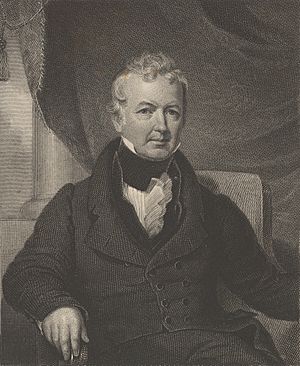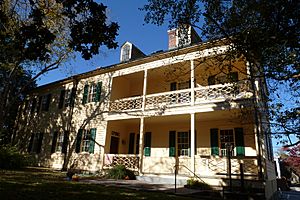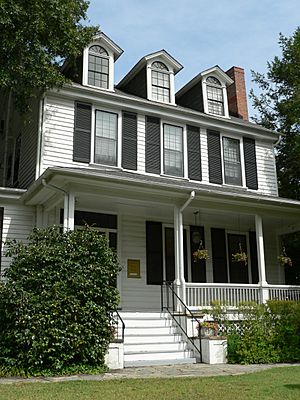William Gaston facts for kids
Quick facts for kids
William Gaston
|
|
|---|---|
 |
|
| Member of the U.S. House of Representatives from North Carolina's 4th district |
|
| In office March 4, 1813 – March 3, 1817 |
|
| Preceded by | William Blackledge |
| Succeeded by | Jesse Slocumb |
| Personal details | |
| Born | September 19, 1778 New Bern, North Carolina |
| Died | January 23, 1844 (aged 65) Raleigh, North Carolina |
| Political party | Federalist, Whig |
| Spouses |
Susan Hay
(m. 1803; Hannah McClure
(m. 1805; Eliza Ann Worthington
(m. 1816; |
| Children | 5 |
| Residences | Coor-Gaston House Elmwood |
| Education | Georgetown University |
| Alma mater | Princeton University |
William J. Gaston (born September 19, 1778 – died January 23, 1844) was an important American politician and judge from North Carolina. He served in the United States House of Representatives and later on the state's highest court.
Gaston is famous for writing "The Old North State", which is the official state song of North Carolina. Many places are named after him, including Gaston County, North Carolina, the city of Gastonia, North Carolina, and Lake Gaston. Even a large auditorium at Georgetown University, his old school, is called Gaston Hall.
Contents
Early Life and Education
William J. Gaston was born in New Bern, North Carolina, on September 19, 1778. His parents were Dr. Alexander Gaston and Margaret Sharpe.
At age thirteen, he became the very first student at Georgetown Academy in Washington, D.C.. He had to leave early due to illness, making him its first dropout too! After some more schooling in North Carolina, he went to the College of New Jersey (now Princeton University). He graduated in 1796 and studied law there.
Political Career
Gaston became a lawyer in 1798 and started his practice in New Bern. He quickly became involved in politics. He served in the North Carolina General Assembly in 1800. Later, he was a member of the State House of Commons from 1807 to 1809. He even served as its Speaker, which is like the leader, in 1808. In 1812, he was a member of the North Carolina State Senate.
In 1813, Gaston was elected to the United States House of Representatives. He served there from March 4, 1813, to March 3, 1817. While in Congress, he helped Georgetown College get its federal charter, which was a big deal for the school.
Gaston did not run for Congress in 1816. He returned to serve in the North Carolina Senate again from 1818 to 1819. He also served in the U.S. House of Representatives for shorter periods in the 1820s and early 1830s.
Views on Slavery
In 1832, Gaston gave a speech at the University of North Carolina. Even though he owned enslaved people, he spoke about the need to end slavery. He said that slavery was "the worst evil" affecting the Southern states. He believed it held back progress and hurt the community. He hoped North Carolina would eventually get rid of it. This was a very brave statement for his time and place.
Judicial Role and Religious Freedom
In 1833, Gaston was appointed to the North Carolina Supreme Court. He had actually helped create this court as a legislator back in 1818. He served as a judge until he died. He even wrote a decision that limited how much control slave owners had over enslaved people.
Gaston was a Roman Catholic. At the time, North Carolina's constitution seemed to prevent Catholics from holding public office. However, Gaston was elected many times. He played a key role in the Constitutional Convention of 1835. Thanks to his efforts, official discrimination against Catholics was removed from North Carolina law. This was a major step for religious freedom in the state.
Family Life and Legacy
William Gaston was married three times. His first wife was Susan Hay, whom he married in 1803. She passed away in 1804. His second marriage was to Hannah McClure in 1805. They had three children together:
- Alexander Gaston (1807-1848)
- Susan Jane Gaston (1808-1866)
- Hannah Margaret Gaston (1811-1835)
Hannah McClure died in 1813. Gaston's third marriage was to Eliza Ann Worthington in 1816. They had two daughters:
- Elizabeth Gaston (1817-1874)
- Catherine Jane Gaston (1819-1885)
William J. Gaston passed away in his office in Raleigh, North Carolina, on January 23, 1844. He was buried in Cedar Grove Cemetery in New Bern. His former homes, the Coor-Gaston House in New Bern and Elmwood (Raleigh, North Carolina) in Raleigh, are now recognized as historic places.




